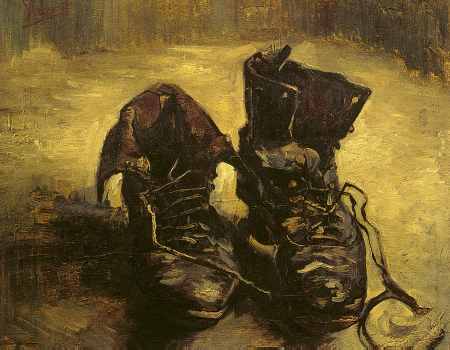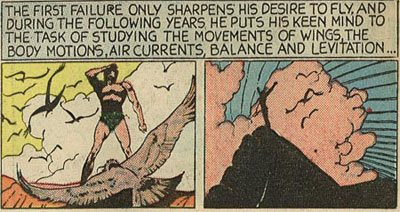|

SHOES
Vincent van Gogh
ZEN ENLIGHTENMENT
AND THE ART OF TYING SHOES
the Wanderling
Have you ever heard an old Zen saying that goes something like: "When you are hungry, eat. When you are tired, rest. When you are cold, put on extra flannel."(see)...Well, tying shoes fits right in there and is a key to the understanding or grasping of things Zen.
Shoe tying is best learned in short (10-minute) sessions in an
environment free from distractions so the frustration level will be kept to a minimum.
The two most popular methods of tying shoes are the bunny ears and the
one-loop wrap. The bunny ears method is easier to understand
although it requires more coordination. In this method you begin with a basic half
knot and make two bunny ears or loops. Cross one loop over the other, wrap it around and
under the other loop. Complete by pulling both loops tight. Sometimes your own hands
get in the way with this method if you do not have sufficient hand dexterity to
isolate your index fingers.
A one-loop wrap method requires less refined motor coordination. Hold a lace in
each hand. Put each lace in the other hand to make a letter X. It is less
confusing if you always use the dominant hand to put one lace under to tie a half-knot.
Success depends on which way you wrap the lace before going under and will be most
successful if you discover your own which way to go. Start over if you go the
wrong way, instead of correcting mid-task, so that you learn the correct method
without needing directional cues. You need good bilateral coordination to use both
hands to pull the ends of the laces tight. When you have mastered tying a half-knot
independently, you are ready to learn the one-wrap method.
Make a loop to hold in non-dominant hand. Put two dots on
the shoelace to match up when you make the loop. Otherwise, you will eventually
figure out with practice how to make a loop on your own. Hand-over-hand, help
lay the lace over the loop, wrap it around and begin to push it under the loop to create
the second loop. Now you should change your hold on the first loop and prepare to
pull both loops tight. Verbal directions should be kept to a minimum if each shoe
tying attempt is set up to end successfully.
How many of you that tie your shoes ever really THINK about it when doing it? Not many, probably. The function somehow becomes an ingrained second nature ablity. So how did you learn? Someone probably showed you, or you watched an older sibiling that learned prior to you, or perhaps it was peer pressure, or trial and error of doing it over and over. The same goes for such things as swimming, riding a bicycle, or typing.
In the above few paragraphs I have presented over THREE HUNDRED words explaining how to tie your shoes, three hundred words you don't even use or think about while tying your shoes. The truth is, you probably couldn't even tie your shoes if you concentrated on the words. However, you probably could if you didn't!
TAKE THE FOLLOWING LITTLE TEST:
Starting with a pair of shoestring tie-type shoes, take off both shoes. Call up the following relatively long BUT super interesting link by simply clicking for example, The Code Maker, The Zen Maker, or perhaps something a little more on the lighter side, but equally spiritual in it's own way, Of Cobras, Scarabs, Maseratis, and Zen --- or anything else that you can think of for that fact that you might like to read. In a comfortable position with both shoes at close reach, sit in front of the computer and start reading the material, or any page, book, magazine or paper. Part way into your reading, while continuing to read, reach down and put on one shoe, then the other. As you continue to read, tie both shoes. Finish reading. The question comes up, how DID you tie your shoes? It's a Zen thing.
It is that same ingrained second nature ablity we are after here. As related to Enlightenment and things Zen you will run into words such as the three S's: Samadhi, Siddhis and Satori, as well as words such as Kensho, and a variety of "number" concepts such as The Four Bodhisattva Vows, The Five Degrees of Tozan, The Ten Fetters of Buddhism and Twelve-year Rule...but WHAT are they, what do THEY mean? What does the Twelve-year Rule or The Ten Fetters have to do, if anything, with Enlightenment or your quest or interest in it? Are they some sort of steadfast rules you HAVE to follow or NO Enlightenment or are they more like the Law of Gravity --- a sort of natural order of things?
It is often said that when you truly need a teacher, one will appear. This may due to some inexplicable serendipity. It may be due to the fact that the seeker has searched deeply within himself or herself and determined what sort of instruction seems to be required. It could be a spiritual desperation on the part of the seeker, or a successful sales pitch by a teacher (sincere or not). It may be a combination of the previous factors, or some intuitive awareness beyond expression. For whatever the reason, the saying often applies and the results can be found most eloquently in the following:
SRI RAMANA MAHARSHI: THE LAST AMERICAN DARSHAN
RECOUNTING A YOUNG BOY'S NEARLY INSTANT TRANSFORMATION INTO THE ABSOLUTE DURING HIS ONLY DARSHAN WITH THE MAHARSHI
It should be noted that Adam Osborne, who, as a young boy grew up at the Ramana ashram and the son of one of the foremost Ramana biographers Arthur Osborne, played a prominent role in the Last American Darshan as linked above.
Fundamentally, our experience as experienced is not different from the Zen master's. Where
we differ is that we place a fog, a particular kind of conceptual overlay onto that experience
and then make an emotional investment in that overlay, taking it to be "real" in and of itself.

(PLEASE CLICK)

THE BLACK CONDOR: THE MAN WHO COULD FLY LIKE A BIRD
(please click)
CLICK
HERE FOR
ENLIGHTENMENT

ON THE RAZOR'S
EDGE
MIRROR SITE I
MIRROR SITE II
|

